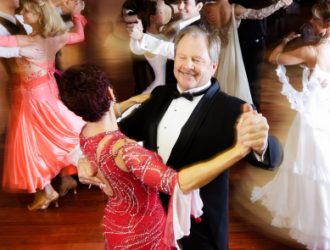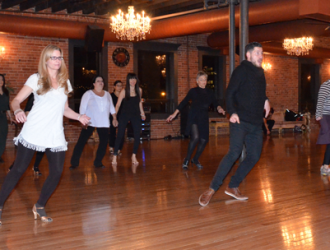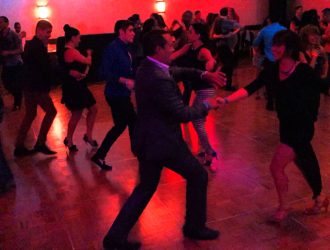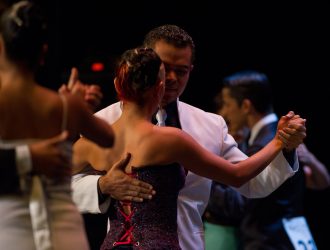Social Dancing
Social Dancing is a major category or classification of dance forms or dance styles, where sociability and socializing are the primary focuses of the dancing
Overview#
Many social dances are partner dances. In fact, quite often when spoken about social dances, ballroom or other partner dances are kept in mind. However it is natural to include in this category such groups of dances as circle dances, line dances, novelty dances, or simply club dancing in solo.
Ballroom dance, depending on how it is defined, may refer to a wide variety of partner dances. Typically it includes Standard (also termed Smooth or Modern) dances such as waltz or foxtrot, and Latin (also termed Rhythm) dances such as Cha Cha Cha and Rumba. Standard dances are normally danced to straight-beat, Western music; couples dance around the floor; and when formalized, the lady wears a long gown and the gentleman a bow-tie and tails. Latin dances are normally danced to off-beat, Latin or jive music; couples may dance more-or-less in one spot or move around the floor; and when formalized, the woman wears a short-skirt latin outfit and the man dresses in black.
The dances taught in this class include those listed on the left menu bar. These are mostly from the dance group of international standard and international latin. However, we will also learn some nightclub, square and line dances.
History#
Social Dance in the West#
The types of dances performed in social gatherings have evolved as society’s values have shifted.
14th Century#
The Social Dancing of the 14th century have been preserved by musical scores, but there are not currently choreographic representations of them. These dances include the balli (also called the ballo), carola, stampita, salterello, trotto and roto.
15th Century#
he 15th century, also known as the Early Renaissance, is the first period of time in the West with written records of the types of social dance. Dancing was especially important for the courts during this time. A manuscript handwritten in Brussels highlights the Burgundian court dance referred to as the Bassedanse. In the Bassedanse, a large group of dancers perform a series of steps in triple time. The Italian courts also did this dance, the Bassadanza as they called it, for social purposes. Their version was lighter and had more intricate choreography. The Italian courts also danced the Balli, in which the music and dance phrases could not be separated like those of the Bassadanza. Choreographers used a wide array of rhythms, steps and positions in creating the Balli dances for a set number of dancers. The Balli and Bassadanza, or Bassedanse when referring to Belgium, were documented in instruction books by the highly respected dance masters who choreographed them for the courts.
16th Century#
The Social Dancing of peasants and lower class citizens were not recorded until the Late Renaissance. According to Richard Powers, instructor of historical and contemporary social dance at Stanford University, courtiers in the late 16th century continually had to “prove themselves through their social skills, especially through dance.” The recorded social dances of the late 16th century include the Spanish Pavan with intricate footwork and the stamping Canario. While most scripture discusses the court dances, the book Orchesography describes the peasant Branles as well as a few other dances such as the 16th century Basse Danse and La Volta. An exchange of social dances occurred between the peasants of the countryside and the aristocrats of the court “as they wore out,” according to Powers.
Baroque Era#
During the Baroque Era, dancing at court balls was a display of social status. A formal ball opened with a branle, in which couples stood in a line in order of their place in the social hierarchy. The most highly regarded couples would dance first. Some of the couple dances included the Menuet and the Gavotte. Once all couples had danced, the attendees would end the ball with popular English countryside dances, called Contredanses. The French Revolution in 1789 created a shift toward less courtly, rigid social dance.
19th Century#
During the Regency Era, from 1811-1830, the Quadrille became the most popular dance in England and France. The Quadrille consisted of a large variety of steps that skimmed the ground, such as chassé and jeté. Most other dances of this era, such as the Mazurka, were performed in lines and squares.
The waltz, which arose during the Romantic Era from 1840-1860, was a partner dance in which partners danced more closely than had previously been considered acceptable. In the waltz, neither partner led. Individuals danced as equals, which was a new phenomenon at the time. The Polka was another dance that arose during ths time in which partners were scandalously close. According to Powers, the dances of this time were “fresh, inventive, youthful, and somewhat daring,” which mirrored society at the time.
20th Century#
Towards the end of the 19th century, Americans were tiring of the court dances of their grandparents’ era. In the early 20th century, Americans began pairing Victorian dances such as the Two-Step with Ragtime music. Other dances included the African American Cakewalk, and animal dances such as the Turkey Trot (dance). The most popular social dance of the time was the One-Step. The dance consisted of couples taking one step on each beat of the music, so even beginners could participate.
Rock ‘n’ roll in the 1950s brought about a shift in social dancing toward rebelliousness. This shift was seen especially in teenagers who did not want to dance the same steps that their parents did. The dancing was mostly swing based but had a variations in different regions. Couples began dancing as individuals for the first time, sending the message that there did not have to be a leader and a follower.





